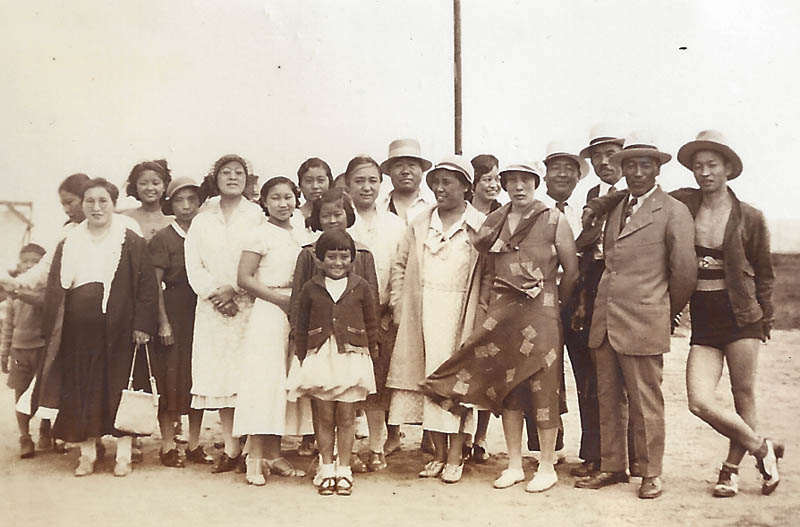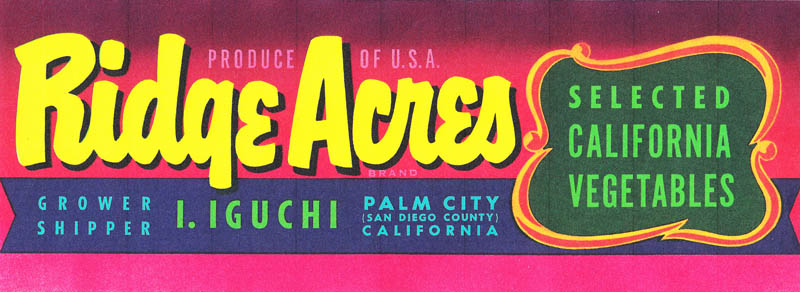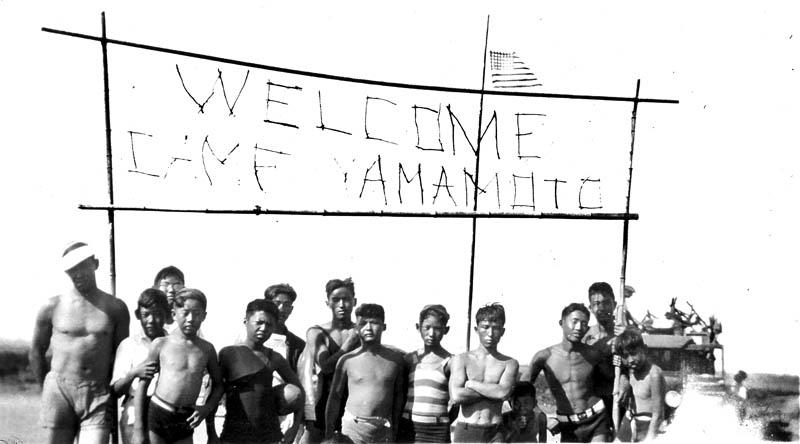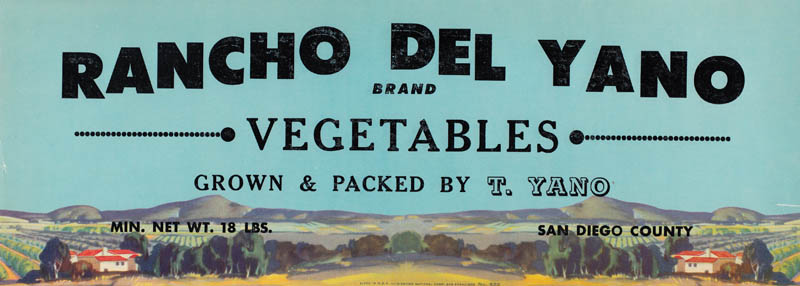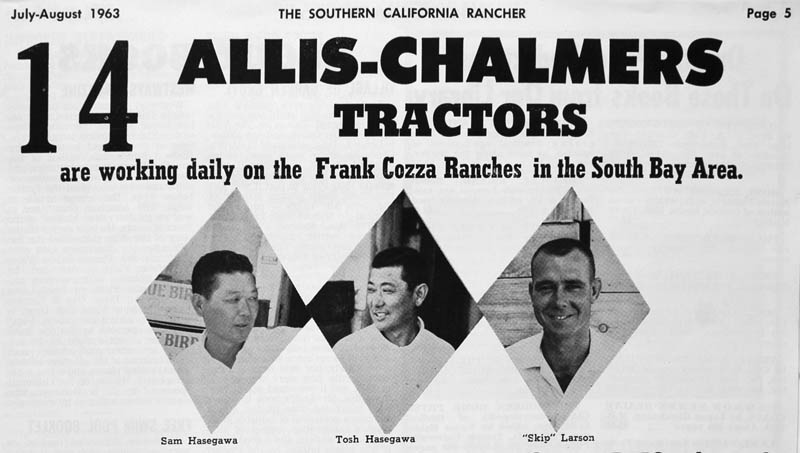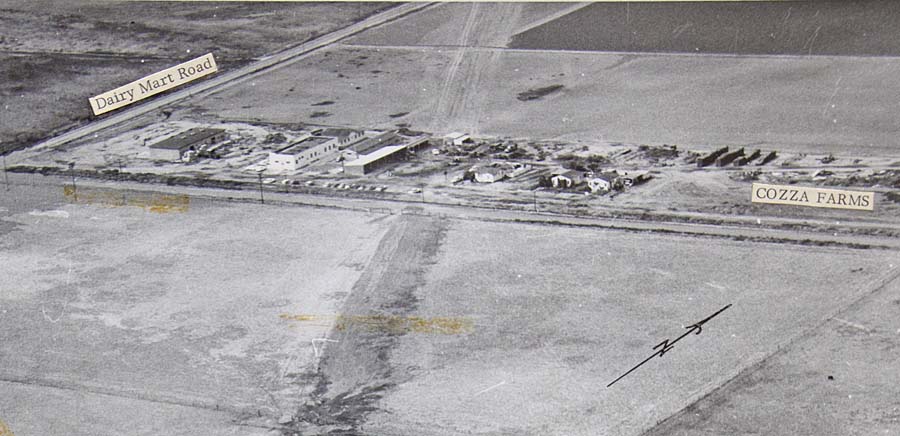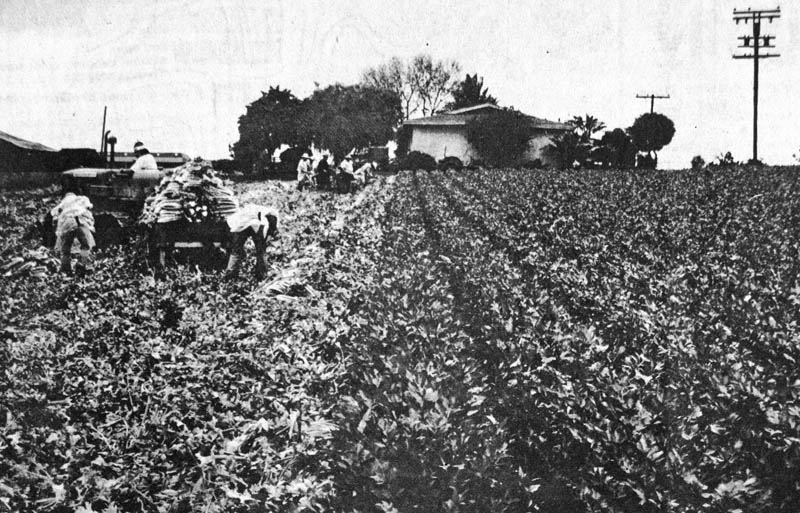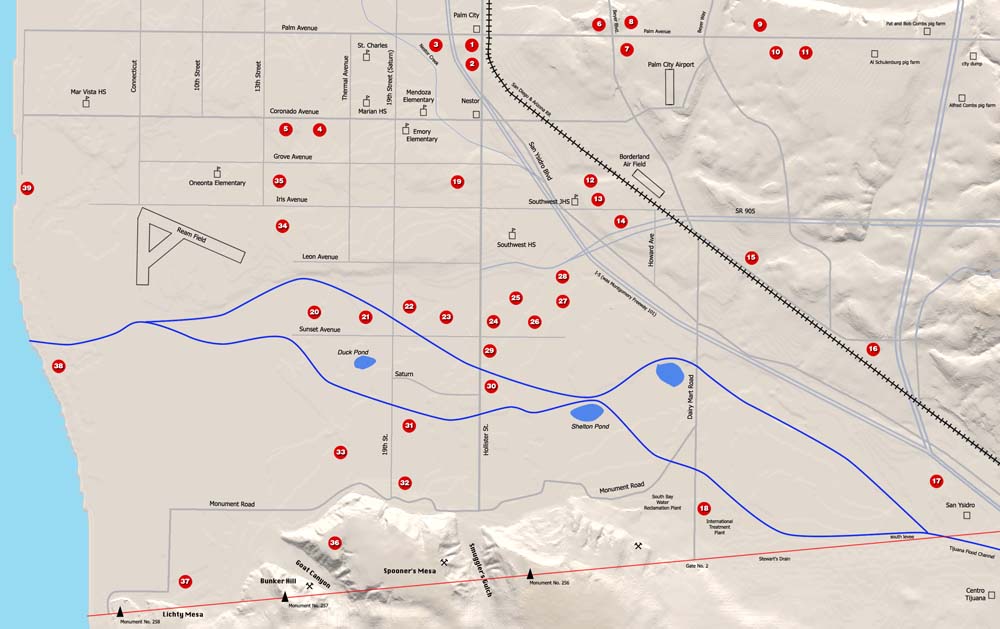|
Japanese in the Tijuana River Valley
by Steve Schoenherr
Visitors at "Camp Yamamoto," in the Tijuana Slough in 1933.
(Photo courtesy of Japanese American Historical Society of San Diego Archives, San Diego, CA.) 1915 - The first Japanese to farm in valley were the Iguchi brothers, Kiyotaro and Kumataro, and Sataro Owashi near Palm City. Sataro's son, Joseph Owashi, was born on the Palm City farm. After returning from the World War II relocation camp, Joseph Owashi continued farming in the South Bay and was the San Diego County Farmer of the Year in 1970. He was president of the San Diego County Japanese-American Citizens League and founding president of the Chula Vista Vegetable Growers Association. (South Bay Historical Society Bulletin No. 9, July 2015) 1920 - The 1920 census listed Iwaguchi Iguchi, 52, and his wife Mine. ( U. S. Census of 1920, California, San Diego County, San Diego Township, Nestor Precinct, District 236 )
Ridge Acres vegetable label of I. Iguchi, Palm City..
(Photo courtesy of Japanese American Historical Society of San Diego Archives, San Diego, CA.) 1930 - The 1930 census listed the following: Mike Iguchi, 33, and wife Mitsuko. Hifmi Hondo, 46, and wife Hicayo, on County Rd. Isuke Iguchi, 55, wife Asano, son Mitsurie and son Isen, on Harris Ave. Ejiro Inouye, 56, wife Ume, on County Road. Mike Ozaki, 30, on County Road. Yonetaro Yamaguchi, 37, wife Takino, on County Road. Jimper Imaizumi, 46, and wife Fusa, on Monument Road ( U. S. Census of 1930, California, San Diego County, San Diego Township, Nestor Precinct, District 215 ) 1930 - Kikuichi Marumoto farmed in the valley in the 1930s with his wife Mary Wada, brother-in-law Frank Wada, and daughter Jeanne, who later became a nurse and married William Elyea. Jeanne recalled that her mother Mary Sumiko Wada was born in Redlands California and her father Kikuch Marumoto was born in Hiroshima Japan. She lived with her family in Tijuana Valley before World War II where her parents worked as farmers. Along with her mother and father, Jeanne grew up with three sisters and a brother. Her parents where both seen as good people, although her father was strict with his family. By 1942 Jeanne and her family, with the exclusion of her mother who was giving birth to her sister, where relocated to a Japanese American internment camp in Arizona. After she left the internment camp with her family, she would return to life as a farmer's daughter in California. Jeanne attended 1st grade at Emory Nester. Upon returning home everyday she would help her family with farm work. Jeanne would later graduate from Chula Vista High School and look for a job to help her family, rather than stay home like her father wanted her to. After graduation, she applied for a job at McCausland Robinson Clinic, which she was lucky enough to be hired regardless of her lack of experience. Working at the Clinic she was recommended by her coworkers to join a nursing program at San Diego City College in 1957. Jeanne received her Medical Assistant Certificate from City College in June 1958. (San Diego City College Student Biography Projects, 2013) 1933/05/18 - The Imaizumi farm was located on Monument Road. Isao Iamizumi of Monument represented Sweetwater High School in the 100-yard dash in the preliminaries of the Southern California track meet held at State College. ( San Ysidro Border Press, May 18, 1933 )
Boy Scout Troop 52 held its first summer camp, "Camp Yamamoto," at the Tijuana Slough in 1933..
(Photo courtesy of Japanese American Historical Society of San Diego Archives, San Diego, CA.) 1933/08/14 - (photo) Boy Scout Troop 52 held its first summer camp, "Camp Yamamoto," at the Tijuana Slough in August of 1933. The individuals shown in the above photograph are not identified. According to the troop scrapbook, troop officers included three adults: Frank Otsunka, John Yamamoto, Mr. Rummel. Officers also included three scout leaders: Fred Katsumata, Frank Ono, Moto Asakawa. Members of the troop included 11 boys: Take Tamiguchi, Ben Masumoto, Yoshiyasir Tsumagari, Minoru Tsumagari, James Suzuki, George Suzuki, Benson Iwata, Hayai Abe - S.P.L., George Morikawa, Yoshio Matsumoto, Joe Sakamoto. Troop 52 was sponsored by the Japanese Congregational Church. Troop 72 was another troop that was formed in the early 1930s and sponsored by the San Diego Buddhist Temple. Troop 72 also spent a week in 1935 camping in the Tijuana Slough. ( Boy Scout Troop 52 Scrapbook 1935-36, Japanese American Historical Society of San Diego Archives, San Diego, CA. ) 1935 ca - Rancho Del Yano is the label of Tokihira Yano, better known as "Toki." The Yano family are among the pioneering Nikkei farm families in San Diego County. Initially farming in Mission Valley, the family moved to the Tijuana River Valley in the 1930s. After the World War II removal and detention the family began to farm in Imperial Beach, California where this label was brought into use. The specialty of the Yano family was pole tomatoes. (Historical Lug Labels, 2009)
Rancho del Yano vegetable label of T. Yano, San Diego County..
(Photo courtesy of Japanese American Historical Society of San Diego Archives, San Diego, CA.) 1935 ca - Prior to World War II, the Itami family farmed in the Tijuana River Valley and throughout the South Bay. The Itamis farmed specialty crops including celery, tomatoes, cucumbers and squash which were sold directly to the Los Angeles produce markets. ( Historical Lug Labels, 2009 ) 1940 - The following are listed in the 1940 census: Kiyotauro Iguchi, and wife Chiyo and family, are listed on Sunset Lane near San Ysidro Highway, truck farm proprietor. Isuke and Asano Iguchi on the San Ysidro highway. Kiyataro and Cliyo Iguchi on Sunset Lane. Moto Oto, 42, on Gate No. 2 Road. Miochi Kido, 60, on Gate No. 2 Road. Kichiyiro Itami, 60, on Gate No. 2 Road. KiKuichi Marumoto, 36, and wife Mary, and daughter Jeanne, and brother-in-law Frank Wada, on Monument Road. Kazazi Segawa, 51, wife Misuye, 6 sons, 4 daughters, incl Ben, 9, on Sunset Lane. Jimpei Imaizumi, 55, son Isao, boarder Takesachi Sakurai, 19, on Sunset Lane. Tokihira Yano, 22, father Sakuhichi, 52, 3 sisters, 2 brothers, on Banana Ave ext. Tokugoro Furuta, 62, wife Tugi, 2 sons, 2 daughters, on Banana Ave ext. Tbumeiki Hirata, 59, wife Majono, on Banana Ave ext. ( U. S. Census of 1940, California, San Diego County, National Township, District 37-64 ) 1941/12/07 - "On the day of the Pearl Harbor attack, a black car showed up at Walter Stewart's ranch house. It was the FBI looking for one of the family's Japanese neighbors. There were 15 to 20 Japanese families farming in the valley at that time, and all were eventually interned in camps in California and Arizona. Japanese family names included Miroko, Itami and Fujito. In some cases the field hands and caretakers would continue to run the farm for them after they were interned and would save the profits in the bank. Others were taken advantage of and lost everything during the war." (San Diego Union-Tribune, May 31, 2008) 1945 - Japanese farmers returned from relocation camps after World War II and worked at a number of farms along Sunset Avenue. East of Hollister were the farms of Fred Iguchi, Tbuneiki Hirata, Miochi Kido, George Niso, Nobuso Kido, Yaemon Hamano, Roy and Frank Segawa and the Imazuma family. West of Hollister were the farms of Sam Itami, Tbuneiki Hirata, Toki Yano, and Tokugoro Furuta. (South Bay Historical Society Bulletin No. 9, July 2015) 1945 - Frank and Kay Fukamizu were the last to leave Poston. By this time, all of the hostels were full, and because of this, they moved in with another family, the Iguchis, in Otay, Palm City. The couple was already acquainted with the Iguchis from Poston, where both families lived in the same block. With Mrs. Iguchi, Frank Fukamizu helped work on the farm, while Kay kept house. In addition, Frank Fukamizu harvested celery for other farms. Kay's brother was Charlie Torio. (Regenerations Oral History Project, Japanese American National Museum, 2000.) 1948 - The Oyama family began farming east of Smugglers Gulch on Monument Road. Kajiro Oyama came from Japan in 1914 as a teenager, and went into farming in Chula Vista. Because the Alien Land Law in California prohibited aliens from owning land, Kajiro bought land in 1934 in the name of his American-born son Fred Oyama. When the family was sent to the relocation camp in World War II, the state of California tried to seize the Oyama farm. In a legal case known as Oyama v. California, the Supreme Court ruled in 1948 that this seizure was illegal. In 1952, Congress changed citizenship laws so that nobody was excluded based solely on where they came from. Kajiro Oyama became a U.S. citizen, a landowner and farmed around San Diego County, including Vista and the Tijuana River Valley. He was 99 when he died in 1998. (San Diego Union-Tribune, Sept. 21, 2008) 1945 - The Mike Yamagata farm was east of Goat Canyon near border, with his brother of Harold. ( South Bay Historical Society Bulletin No. 9, July 2015 ) 1950 - The Frank Tachiki farm was along 19th street in the 1950s and 1960s. (South Bay Historical Society Bulletin No. 9, July 2015) 1954 - Cozza Farms moved into the Tijuana River Valley in 1954. The first farm of Frank and Jim Cozza was located on Gunpowder Point in Chula Vista. This farm at the end of D Street was leased from the Santa Fe Railroad from 1946 to 1954. Frank Cozza and Sam Hasegawa managed the farm; Jim Cozza and Tosh Hasegawa managed the produce end in Los Angeles. The Hasegawas' father, Kinzaburo, also farmed at the Chula Vista site until his death in the early 1950's. The main crop was tomatos but included other truck farm vegetables during the other seasons ( lettuce, cucumbers, etc.). In 1954 this lease expired and Cozza Farms was outbid by Sam Vener. Cozza Farms purchased the old C. S. Howard stock farm above and below San Ysidro Blvd. in 1954. Frank Cozza lived in the two-story house at XXXX Iris Avenue. In the 1960s the farm moved to Dairy Mart Road and operated until the 1980s. ( email from Sumiyo E. Kastelic, daughter of Tosh Hasegawa, May 16, 2012 )
This advertisement featured Sam Hasegawa, Tosh Hasegawa, Skip Larson of the Cozza Farms..
( The Southern California Rancher, July-August, 1963, magazine 00-184, Chula Vista Public Library. ) 1963/03/17 - SDG&E hosted a tour of farms for a group of Canadian farmers, to Otay Packing Co. of Ken Tachiki, then to the Cozza farm, then to the Norman Semenza radish farm in San Ysidro, then to the Frank Yonekura farm ( Chula Vista Star-News, March 17, 1963. ) 1969 - George Yamamoto bought the farm on Monument Road farm in 1969 from Paul Oyama. George was the son of Naburo Yamamoto who farmed in Castle Park after World War II. (South Bay Historical Society Bulletin No. 9, July 2015)
The vegetable label of Naburo Yamamoto & Sons, Chula Vista..
(Photo courtesy of Japanese American Historical Society of San Diego Archives, San Diego, CA.) 1970 - The "drip irrigation" revoution started by Richard D. Chapin in 1954 came to the South Bay in 1970. Toshiaki Hasegawa planted two Iong rows of pole tomatoes on a small plot in back of his home located at 2975 San Ysidro Boulevard in San Ysidro, California. Hasegawa expanded the project to a five acre plot located on the old C. S. Howard horse farm, just across Iris Avenue, south of the site of Southwest Junior High School. In the spring of 1970 Hasegawa decided to further expand the drip system to a 25-acre plot located in the Tijuana River Valley east of Dairy Mart Road. ( Estes, "South Bay Monogatari," 1996. ) 1971/05/09 - UFWOC suit seeks injunction, damages of San Ysidro farm. Another suit by the United Farm Workers Organising Committee accusing a tomato grower of trying to stop unionization of field workers in San Diego County was filed Thursday in Superior Court. Tochi Hasegawa and Cozza Firms, Inc.. of Dairy Mart Road, San Ysidro, were named as defendant. The action asks a restraining order, an injunction and damages of $10,000 for each of five workers it Is charged were fired for their union activitles. The workers are Miguel Gonzales, Guadalup Gonzales, Jose Gonzales, Juan Islas Barrias and Luis Salcieda. Each of these is named as a plaintiff. Marge Cowan, organizer of UFWOC activities in the county, is also a plaintiff. The suit alleges that Hasegawa on April 21 told the five they were no longer needed and that his only reason for doing so was their union activities. The first suit filed by UFWOC was against Egger and Ghio Co., Inc., another South Bay firm. That suit resulted in a counter suit, and there are now three suits against the grower and three against the union. ( The Chula Vista Star-News, May 23, 1971. )
Cozza Farms is shown in this 1976 photo after Dairy Mart Road was realigned westward to connect with Monument Road. The old Dairy Mart Road that led straight to the border is still visible in the center of the photo. (Courtesy of IWBC).
1971/05/27 - The Cozza Farm is the second South Bay Farm to have a labor dispute with United Farm Workers. The strike against the Egger-Ghio Farms began in March. Tochi Hasegawa was in charge of the Cozza farms when the packing shed burned yesterday in an arson fire, held 3000 cabbage cartons ready for the harvest season now in progress. UFWOC sues Cozza Farms for not hiring fired workers. but Federal Court Order has banned green card workers from working at struck ranches. Case postponed until June 10th. UFWOC brings suit against Cozza Farms for firing five workers for their union membershlp. ( Chula Vista Star-News, May 27 and June 3, 10, 1971)
Workers picking celery at Palm Ave. and Beyer Blvd. in South San Diego. The 28 acres of farm land shown here are owned by Isen Iguchi. (Imperial Beach Star-News, Jan. 13, 1980)
Map of Japanese farms in the Tijuana River Valley 1915-1968. The identification for each number is listed below.
1 - Kiyotaro Iguchi, one of the two first Japanese to farm in Palm City. The Iguchi brothers (Kiyotaro and Kumataro) were working seventy acres in Palm City by 1915, poss since 1905. 2 - Sataro Owashi, one of the two first Japanese to farm in Palm City. 3 - Frank and Kay Fukamizu were the last to leave Poston, moved in with another family, the Iguchis, in Palm City, and farmed a Mexican farmer's place, Rodriguez. The family moved to Chula Vista in 1948 where Kay's brother, Charlie Torio, after discharged from the Army, began farming. Frank Fukamizu received a supervisory position to manage apartment complexes in the area. Kay volunteered at the Buddhist Temple of San Diego, and Kiku Gardens. 4 - Yaemon Hamano, vegetable farmer on the Highland Road in Nestor, next to Kida, listed in the 1940 Census. 5 - Nobuso Kida and wife Chieko and family, truck gardener on the Highland Road in Nestor, listed in the 1940 Census. 6 - Frank Tachiki, 2877 Palm, in 1965 directory. 7 - Isen P. Iguchi, 2910 Palm, in 1965 directory. 8 - Takeguichi farm was the location of the Palm Pacifica on Beyer and Palm. - 1940 9 - Kikuichi Marumoto, 3565 Palm, in 1965 directory. 10 - Mrs. Umeno Itami, 3801 Palm, in 1965 directory. 11 - Masami S. Itami, 3811 Palm, in 1965 directory. 12 - Frank Tachiki farmed north of Howard Ranch up to Palm Avenue after World War II. 13 - The two-story house at 2876 Iris Avenue was built in 1956 for Frank Cozza. 14 - Cozza Farms, 2nd farm took over the Howard Ranch after the war, operated by 2 bros Tosh and Sam Hasegawa. 15 - Toshiaki Hasegawa, drip-irrigated tomato farm in back of his home at 2975 San Ysidro Blvd. 16 - Hezzi Heayashi, vegetable farmhand, lived on San Ysidro Highway, in 1940 Census. 17 - Toakadi Ito and family, truck farmer on Gyrodz Road in San Ysidro, in 1940 Census. 18 - Cozza Farms was located on 60 acres at Dairy Mart Road and Tijuana Street in 1966. Frank and Jim Cozza had started farming on Gunpowder Point in Chula Vista in the 1940s, bought the Howard Ranch in 1954, then moved to Dairy Mart Road and farmed until the International Treatment Plant was built. 19 - Frank Wada, on Monument Rd in Nestor, was farm hand for Marumoto, in 1940 Census. 20 - Tokugoro Furuta farm on Sunset, after 1945. 21 - Toki Yano farm on Sunset, after 1945. 22 - Hirata farm on Sunset, after 1945. 23 - Sam Itami farm on Sunset, after 1945. 24 - Kazuji Segawa farm at Sunset and Hollister, after 1945. 25 - Imazumi farm on Sunset and Hollister, after 1945. 26 - Kenji farm on Sunset, after 1945. 27 - Fred Iguchi farm at Sunset and Iris, after 1945. 28 - Penny Iguchi farm on Iris, after 1945. 29 - Roy Segawa farm on Hollister, after 1945. 30 - Frank Segawa farm on Hollister, after 1945. 31 - The Frank Tachiki farm was along 19th street in the 1950s and 1960s. 32 - George Yamamoto bought his farm in 1963 from Paul Oyama. George was the son of Naburo Yamamoto who farmed in Castle Park after World War II. The land on the east side of old 19th Street was owned by John and Pearl Hull in the 1930s. Today it is the Medallion Farm of Bing Bush, Jr. 33 - Kikuichi Marumoto farmed in the valley in the 1930s with his wife Mary Wada, brother-in-law Frank Wada, and daughter Jeanne, who later became a nurse and married William Elyea. In the 1920s this land was owned by Herbert Peery. 34 - George Niso, on Gate #2 Road near Monument Rd in Nestor, farm hand for Itami, 65 yrs old in the 1940 Census. 35 - Miochi Kido and wife Mysio and family, on Gate #2 Road near Oneonta Road in Nestor, vegetable farmer in 1940 Census. 36 - Yamagata farm on mesa east of Goat Canyon at border, brother of Harold, after 1945. 37 - Sam Morimoto farm at the border at the end of Monument Road, after 1945. 38 - Camp Yamamoto was the first summer camp of Boy Scout Troop 52 in the Tijuana Slough in August, 1933. 39 - The San Diego Japanese Association held annual picnics in the 1920s on the coast south of Imperial Beach pier. SOURCES:
|
|||||||||
|
Home •
About Us •
Next Meeting •
Latest News •
Resources •
Organizations •
Maps •
Exhibits •
Bulletins •
Contact
|
|||||||||
|
This web page was created July 20, 2015, and revised Sept. 13, 2015, by Steve Schoenherr for the South Bay Historical Society | Copyright © 2015
|
